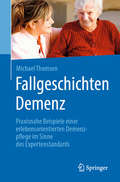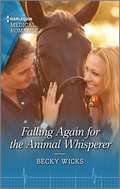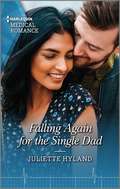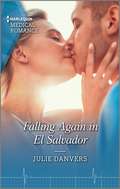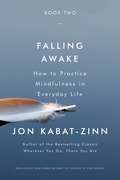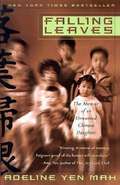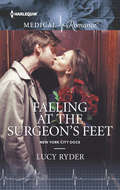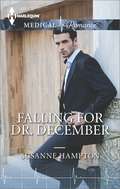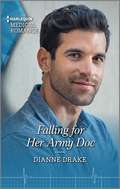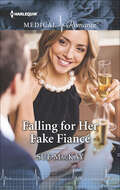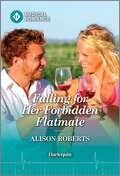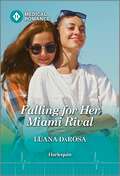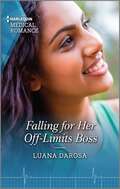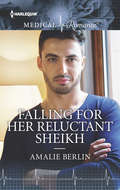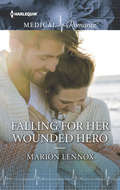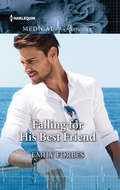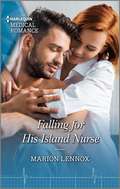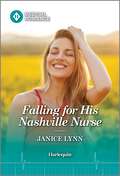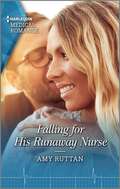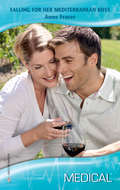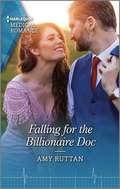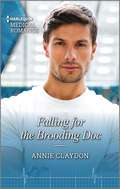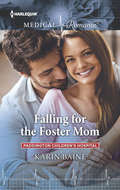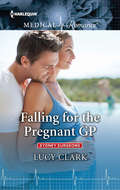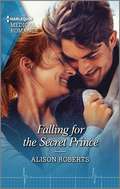- Table View
- List View
Fallgeschichten Demenz: Praxisnahe Beispiele einer erlebensorientierten Demenzpflege im Sinne des Expertenstandards
by Michael ThomsenDas Buch widmet sich im theoretischen Teil den Erkenntnissen namhafter Vertreter unterschiedlicher Demenzpflegetheorien und diskutiert dabei praxisnah die Kernaussagen im Einklang mit den Botschaften des neuen Expertenstandards „Beziehungsgestaltung in der Pflege von Menschen mit Demenz“. Im praktischen Teil stellt der Autor eindrucksvolle Fallgeschichten aus seiner Praxis als Krankenpfleger und Verfahrenspfleger vor. Anhand dieser Fälle kann der Stand des pflegetheoretischen Wissens zum Umgang mit demenzerkrankten Menschen herausgearbeitet und bildhaft gemacht werden. Die Fallbeispiele sind als Ausgangsbasis für das Arbeiten mit Fallgeschichten gedacht und können mit den Weg weisen, wie Teams sich eine „Verstehenshypothese“ im Sinne des Expertenstandards erarbeiten können. Das Buch richtet sich an alle Berufsgruppen, die mit dementiell erkrankten Menschen als Pflege- oder Betreuungsperson beruflich zu tun habe und versucht Antworten auf folgende wichtige Fragen in der Pflegepraxis zu finden: Welche Erkenntnisse von Pflegetheoretikern können gewinnbringend oder erkenntnisleitend sein? Wann handelt es sich wirklich um eine Demenz? Was kann im Team getan werden, um einen besseren Zugang zum demenzkranken Menschen zu finden? Und wie können Pflegekräfte ihre Reflexionsarbeit besser gestalten?
Falling Again for the Animal Whisperer: Falling Again For The Animal Whisperer / Rescuing The Paramedic's Heart (bondi Beach Medics) (Mills And Boon Medical Ser.)
by Becky WicksIs unlocking past secrets…The key to their future?After inheriting half a Dorset veterinary practice, single mom Jodie is dismayed to discover Cole Crawford is her new partner. The renowned vet and animal behaviorist ended their intense love affair twelve years ago. Cole is determined to prove he’s changed, but Jodie has to protect her heart—and her little girl—from further heartbreak. Only, walking away from their practice would be nothing compared to walking away from their reignited chemistry!From Harlequin Medical: Life and love in the world of modern medicine.
Falling Again for the Single Dad: Enticed By Her Island Billionaire / Falling Again For The Single Dad (Mills And Boon Medical Ser.)
by Juliette HylandFatherhood has changed him—But can she risk her heart?ER nurse Amara Patel is starting over. Running into her ex, physician Eli Collins, on her first day at Boston General throws a major wrench in the works! Because despite his still irrefutably sexy appearance, he’s not the Eli she remembers. He’s always put work first, but now that he’s bringing up his niece, everything’s changed—except his and Amara’s feelings for each other! Dare Amara allow herself a second chance at love?
Falling Again in El Salvador: One Night With Her Italian Doc / Falling Again In El Salvador (Mills And Boon Medical Ser.)
by Julie DanversA second chance……could be their greatest adventure!A humanitarian mission in stunning rural El Salvador will give obstetrician Cassie Andover the chance to focus on the medicine that she loves. But the one piece of her past she never expected to find there was the handsome Dr. Bryce Hamlin! And while this bold motorcycle-riding version of Bryce is nothing like Cassie remembers, he’s certainly one she’s compelled to know…From Harlequin Medical: Life and love in the world of modern medicine.
Falling Awake: How to Practice Mindfulness in Everyday Life
by Jon Kabat-ZinnThink you have no time for mindfulness? Think again. "Thoughtful and provocative.... The relevance of this work is unquestionable, as it leaves us inspired and optimistic that true healing really is possible" (Sharon Salzberg). For four decades, Jon Kabat-Zinn has been teaching the tangible benefits of meditation in the mainstream. Today millions of people have taken up a formal mindfulness meditation practice as part of their everyday lives. But how do you actually go about meditating? What does a formal meditation practice look like? And how can we overcome some of the common obstacles to incorporating meditation into daily life in an age of perpetual self-distraction? Falling Awake directly answers these urgent and timely questions. Originally published in 2005 as part of a larger book titled Coming to Our Senses, it has been updated with a new foreword by the author and is even more relevant today. Science shows that the tangible benefits of a mindfulness meditation practice are impossible to ignore. Kabat-Zinn explains how to incorporate them into our hectic, modern lives. Read on for a master class from one of the pioneers of the worldwide mindfulness movement.
Falling Leaves: The True Story of an Unwanted Chinese Daughter
by Adeline Yen Mahfrom the book jacket "I read for two nights, sleepless, my Heart pierced by Adeline Yen Mah's account of her terrible childhood. Falling Leaves is a potent psychological drama pitting a stubborn little girl against the most merciless of adversaries and rivals: her own family. I am still haunted by Mah's memoir. Amy Tan, author of The Joy Luck. Club Born in 1957 in a port city a thousand miles north of Shanghai, Adeline Yen Ma was the youngest child of an affluent Chinese family who enjoyed rare privileges during a time of political and cultural upheaval. But wealth and position could not shield Adeline from a childhood of appalling emotional abuse at the hands of a cruel and manipulative Eurasian stepmother. Determined to survive through her enduring faith in family unity, Adeline struggled for independence as she moved from Hong Kong to England and eventually to the United States to become a physician and writer. A compelling, painful, and ultimately triumphant story of a girl's journey into adulthood, Adeline's story is a testament to the most basic of human needs acceptance, love, and understanding. Scanners note: The Chinese characters found in the printed copy of this book could not be meaningfully represented in the electronic text.
Falling at the Surgeon's Feet: Falling At The Surgeon's Feet Daredevil, Doctor... Husband? Reunited... In Paris! (New York City Docs #3)
by Lucy RyderIt started in an elevator... After a traumatic accident, Dr. Holly Buchanan made a plan: become the world's best plastic and reconstruction surgeon. What wasn't in her plan? Tumbling into an elevator and sprawling at the feet of sinfully sexy new colleague Dr. Gabriel Alexander! For Gabe, getting involved with someone from Manhattan's social elite can only lead to heartbreak. But he's intrigued by Holly's shy charm and intelligent passion. And with Holly bumping into him with every turn she takes, he won't be able to resist her sizzling touch forever!
Falling for Dr. December
by Susanne HamptonHer calendar doc... When Laine Phillips left Uralla twelve years ago she vowed never to return. Now a world-famous photographer, Laine has two rules: not to mix business and pleasure, and to rely totally on herself! It's the only way to protect her heart... But when Laine is forced to return to Uralla for a charity calendar shoot, the scorchingly attractive-and highly uncooperative-Dr. Pierce Beaumont begins to melt the barriers around her frozen heart! Laine's soon breaking both her rules...and falling for Dr. December!
Falling for Her Army Doc: Falling For Her Army Doc / Healed By Their Unexpected Family (Harlequin Lp Medical Ser. #1)
by Dianne DrakeShe’s helping him rediscover his memories… Can she also mend his heart?After an injury in Afghanistan, Mateo Sanchez finds himself in an amnesia clinic in Hawaii. Struggling to piece together how he arrived on the gorgeous island, Mateo may not be the easiest patient, but no-nonsense doctor Lizzie Peterson is determined to help the brooding ex-army doc. Only as Mateo begins to recover do they discover a bond and a temptation that’s so very hard to resist…From Harlequin Medical Romance: Life and love in the world of modern medicine.“...Ms. Drake has delivered a wonderful and very heartfelt read in this book where the chemistry between this couple was just as strong in the present as it was in the past; the romance was delightful and special because these two are meant to be….”—Harlequin Junkie on Second Chance with Her Army Doc““What an enthralling and fast-paced read Ms. Drake has delivered…that drew me in right from the beginning and kept me entertained all the way to the end because of the wonderful main characters….”—Harlequin Junkie on Healing Her Boss’s Heart
Falling for Her Fake Fiancé
by Sue MacKayA temporary arrangement…Kelli Barnett invented a partner to avoid her parents’ matchmaking schemes. So, when her boss Mac Taylor—the man whose kisses once made her melt—offers to step in as her fiancé for a family wedding, Kelli snaps up his offer!Widower Mac believes himself incapable of loving again. Until playing Kelli’s fiancé at the beautiful island retreat throws his senses into overdrive. But Mac must learn to let go of the past for this fake relationship to have a real future…
Falling for Her Forbidden Flatmate (A Tale of Two Midwives #1)
by Alison RobertsIn the first installment of Alison Roberts&’s A Tale of Two Midwives duet, when a midwife has to move in with her best friend&’s brother, she discovers just how tempting forbidden fruit can be… LIVING WITH TEMPTATION To escape her abusive ex-husband, midwife Grace will move to the other side of the world. Even if it means sharing an apartment with her best friend&’s brother. Yet while obstetrician Jock&’s cheeky charm and boy-next-door good looks are difficult to ignore, Grace feels safe in the knowledge that the guarded playboy is firmly off-limits. Although, as their friendship grows, so does their attraction… Succumbing to their physical desire is inevitable. But what happens when she finds herself falling for her flatmate?From Harlequin Medical: Life and love in the world of modern medicine.A Tale of Two Midwives Book 1: Falling for Her Forbidden FlatmateBook 2: Miracle Twins to Heal Them
Falling for Her Miami Rival
by Luana DaRosaAfter battling for the same promotion, two ER docs find their rivalry is just the surface of their feelings for each other… Read more in the latest Harlequin Medical Romance novel by Luana DaRosa! TENSIONS ARE RISING IN THE ER! Dr. Jamie is the backbone of Palm Grove Hospital&’s ER. Raised in foster care, she has always striven to prove her worth at work. So when the promotion that Jamie has worked tirelessly for is given to newcomer Dr. Allegra, the sting of rejection is hard to ignore. Still, Jamie knows that she must push her sore feelings aside and support enigmatic Allegra. And as their professional bond blooms, a personal bond also bursts into passionate life! But when Jamie learns that Allegra is fresh out of a messy divorce, it&’s best they remain rivals…right?From Harlequin Medical: Life and love in the world of modern medicine.
Falling for Her Off-Limits Boss
by Luana DaRosaIn Luana DaRosa&’s debut Harlequin Medical Romance, a doctor faces her greatest challenge yet: resisting her surgeon boss!The flaw in her plan:The surgeon she must resist! Walking into her new Chicago hospital, locum anesthesiologist Emma Santos is ready to take her career by storm. She&’s spent too long neglecting her own goals for someone else. She&’s not ready for widowed surgeon Mark Henderson. Her new boss is hard to please…and heart-stoppingly handsome! And that makes him a threat to both Emma&’s medical ambitions—and her determination not to be ruled by attraction!From Harlequin Medical: Life and love in the world of modern medicine.
Falling for Her Reluctant Sheikh
by Amalie BerlinFalling for a desert prince... Sleep therapist Dr. Adalyn Quinn has had difficult patients before...but gorgeous Prince Khalil Al-Akkari presents a whole new challenge! Darkly brooding, and haunted by the night he failed to save his brother, Khalil is the last man Adalyn should desire... But as they share long nights under a desert moon it becomes impossible to deny their sizzling chemistry. Can Adalyn help Prince Khalil recover the peace that eludes him...even if it means unlocking the heart she's protected for so long?
Falling for Her Wounded Hero
by Marion LennoxA debt repaid...with love? Tom Blake helped Tasha Raymond through a heartbreaking loss eighteen months ago-so when she learns he's been devastatingly injured she's determined to repay the debt by helping him in return. Working with the handsome GP stirs up a storm of emotions, but Tasha has no intention of truly getting close. The playboy's devil-may-care attitude is the last thing she needs! But then the wounded doc's kindness proves too much temptation for her heart to resist...
Falling for His Best Friend
by Emily ForbesThey’ve been friends forever…But now he wants so much more!When nurse Kitty Nelson becomes a surrogate for her sister, her best friend paramedic Joe Harkness is right there for her. But as Kitty’s pregnancy blossoms, Joe begins to see her in a very different light! Finally admitting a connection he’s never felt with anyone else, is it too late to convince Kitty they’re meant to be?
Falling for His Island Nurse: Falling For His Island Nurse / Twin Surprise For The Baby Doctor (Mills And Boon Medical Ser.)
by Marion LennoxCan he prove……her heart is safe with him?For single dad Dr. Angus Knox and his little son, a move to Shearwater Island for a slower pace is just what they need. Angus just didn&’t count on the intense pull he feels to new colleague nurse Freya Mayberry! She&’s super professional, but there&’s something behind her smile that leaves Angus wondering who the real Freya is and how he can persuade her to let him into her world… &“Pregnant Midwife on His Doorstep is a heartwarming romance…. Lennox has penned a very strong story that pulls you forward and leaves you with a great Happily Ever After.&”-Goodreads &“What an entertaining, fast-paced, emotionally-charged read Ms. Lennox has delivered in this book…. The way this story started had me hooked immediately….&”-Harlequin Junkie on The Baby They Longed For
Falling for His Nashville Nurse
by Janice LynnCan a guarded doc take a chance on love with a sunny single mom nurse? Find out in the latest Harlequin Medical Romance by Janice Lynn! FROM A FLING…TO FOREVER? Dr. Wryn appears happy-go-lucky, but past pain bubbles beneath the surface. So it&’s a surprise when Nashville Medical Clinic&’s captivating new nurse, Everleigh, has his traitorous heart racing…which only worsens as he gets to know the single mom and her adorable son. Wryn should keep his distance—Everleigh swore off romance following her divorce. But when she admits to feeling the same, his restraint shatters. If a fling is all they can have, he&’ll treasure every moment. Falling for Everleigh was never part of the plan…From Harlequin Medical: Life and love in the world of modern medicine.
Falling for His Runaway Nurse
by Amy RuttanCould a runaway bride……be the one to tempt him?Brooding Thatcher Bell enjoys the anonymity of life as a cruise ship doctor. But when beautiful Lacey Greenwood storms into his life—wearing a wedding dress!—to take up the vacant post as nurse, he&’s shocked by their instant chemistry. Lacey is obviously escaping something, and Thatcher recognizes some of the pain she&’s hiding behind her dazzling smile. But as they set sail, there&’s no way of running from their real and ever-growing feelings! &“I absolutely loved this cute medical romance. This was the perfect mix of steamy romance and medical drama. The instant attention between these two characters was top notch. If you are a fan of the surprise baby trope mixed in with a steamy medical romance this is definitely the book for you!&”-Harlequin Junkie on Twin Surprise for the Baby Doctor &“Baby Bombshell for the Doctor Prince is an emotional swoon-worthy romance…. Author Amy Ruttan beautifully brought these two characters together making them move towards their happy ever after. Highly recommended for all readers of romance.&”-Goodreads
Falling for her Mediterranean Boss
by Anne FraserDedicated doctor Julie McKenzie is dumbstruck by her new boss. Plastic surgeon Pierre Didier's sexy accent, striking looks and professional expertise make him the most gorgeous man she has ever met! However, Pierre also has a reputation as a playboy--the kind of man Julie knows would never look twice at her. Julie is the last woman Pierre should allow himself to become involved with. If she falls in love it will be for keeps, and forever is the one thing he cannot give her. Yet Pierre is drawn to shy, pretty Julie, and he vows to make her feel like the beautiful woman she really is...
Falling for the Billionaire Doc
by Amy RuttanTwo polar opposites……a once-in-a-lifetime connection!Dr. Kiera is on a mission: to save her hospital! She simply can&’t let this lifeline for the local community vanish. There&’s just one problem—surgeon Henry. He&’s certain that a new, bigger hospital is the key to saving lives, not Kiera&’s small hospital, which is just like the clinic where his fiancée tragically passed away. But it&’s when Henry suddenly finds himself in need of a temporary fiancée that their worlds truly collide! &“I absolutely loved this cute medical romance. This was the perfect mix of steamy romance and medical drama. The instant attention between these two characters was top notch. If you are a fan of the surprise baby trope mixed in with a steamy medical romance this is definitely the book for you!&”-Harlequin Junkie on Twin Surprise for the Baby Doctor &“Baby Bombshell for the Doctor Prince is an emotional swoon-worthy romance…. Author Amy Ruttan beautifully brought these two characters together making them move towards their happy ever after. Highly recommended for all readers of romance.&”-Goodreads
Falling for the Brooding Doc
by Annie ClaydonGoing for gold is nothing……compared to winning his heartFor injured doctor and championship rower Laurie Sullivan, pushing herself to the limit is all she&’s ever known. But enigmatic Dr. Ross Summerby knows she&’s not taking her injury seriously. His shock tactic threat of eviction from his exclusive rehabilitation clinic unless she focuses on her treatment and helps with some of his patients works wonders. But the unexpected connection between them soon makes Laurie dream of a very different future!&“A spellbinding contemporary medical romance that will keep readers riveted to the page, Festive Fling with Single Dad is a highly enjoyable treat from Annie Claydon&’s immensely talented pen.&”-Goodreads&“…I&’ve got to say that this story does not disappoint. Overall, Ms. Claydon has delivered a fantastic read in this book where…the romance was nicely-detailed and had me loving these two together; and the ending made me so completely happy….&”-Harlequin Junkie on Second Chance with the Single Mom
Falling for the Foster Mom
by Karin BaineA family for the bachelor doc? Burns specialist Dr. Matthew McGrory is finally living the bachelor life after years of responsibility raising his siblings alone. But he can't ignore the pull he feels toward beautiful Quinn Grady, foster mom to his favorite young patient. Having learned the hard way that you can't rely on other people, Quinn is überprotective of little Simon, and her heart. But as Matthew's hero status grows in the eyes of her young charge, she just might find he's the hero she's dreamed of, too...
Falling for the Pregnant GP: Falling For The Pregnant Gp (sydney Surgeons, Book 1000) / One Week To Win His Heart (sydney Surgeons, Book 1000) (Sydney Surgeons Ser.)
by Lucy ClarkCould this doctor and her baby bump… be the family he’s longed for?Surgeon Ethan Janeway locked his heart away when he lost his wife and baby daughter. But then he meets gorgeous GP CJ Nicholls, his new—and very pregnant!—boss. After her late husband’s infidelity, CJ has no reason to trust men, but kind, caring Ethan is different. They could be the perfect family—but first they’ll have to leave the past behind…
Falling for the Secret Prince: An Unlikely Bride For The Billionaire Falling For The Secret Millionaire The Forbidden Prince The Best Man's Guarded Heart (Royal Christmas at Seattle General #1)
by Alison RobertsRevealing his past…is a risk worth taking!Dr. Dom di Rossi’s world literally crashes through the ER doors when his father, the king of Isola Verde, is involved in a car crash. Until now, Dom’s royal connection has been carefully guarded. But when Dr. Emilia Featherstone, his old medical school rival, recognizes a previously unseen vulnerability behind his delicious eyes, she unintentionally becomes the keeper of his secret—and his heart!From Harlequin Medical: Life and love in the world of modern medicine.Royal Christmas at Seattle GeneralBook 1: Falling for the Secret Prince by Alison RobertsBook 2: Neurosurgeon’s Christmas to Remember by Traci DouglassBook 3: The Bodyguard’s Christmas Proposal by Charlotte HawkesBook 4: The Princess’s Christmas Baby by Louisa George
